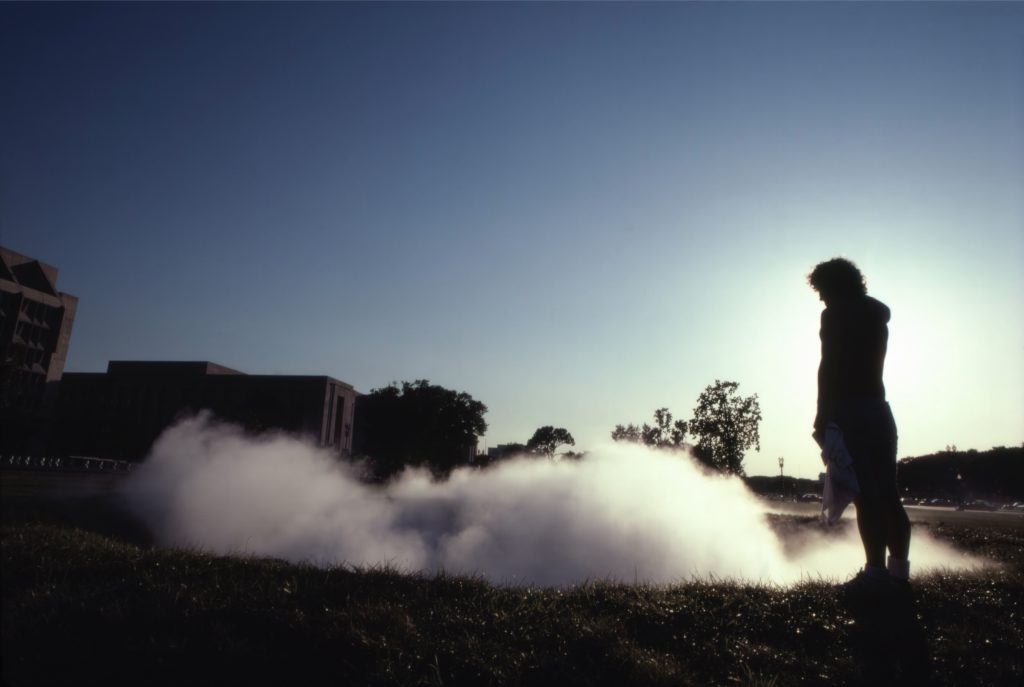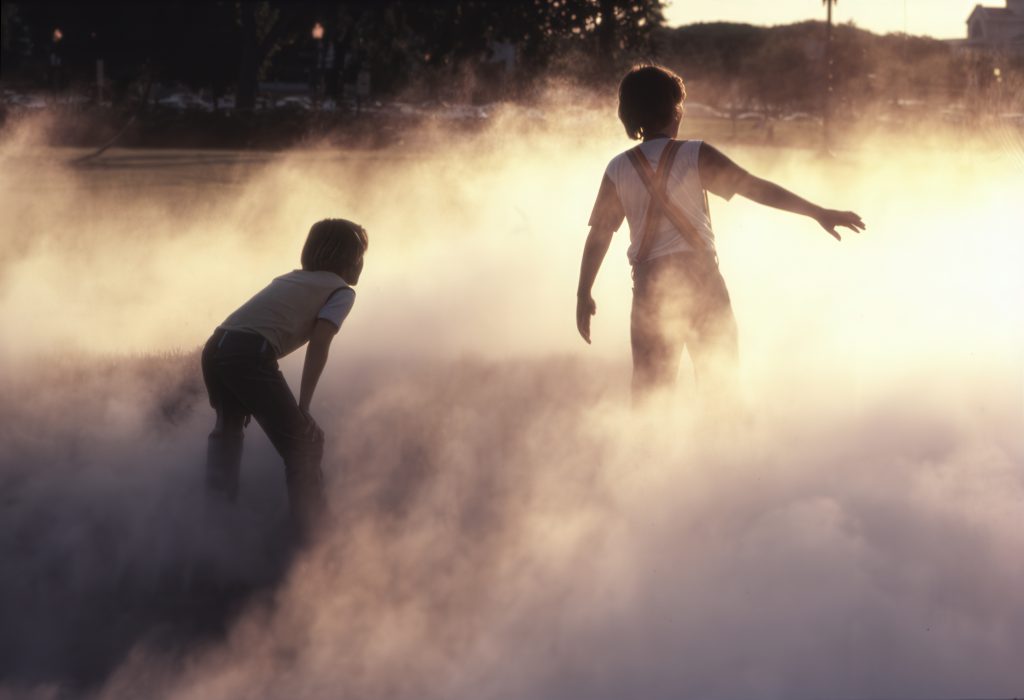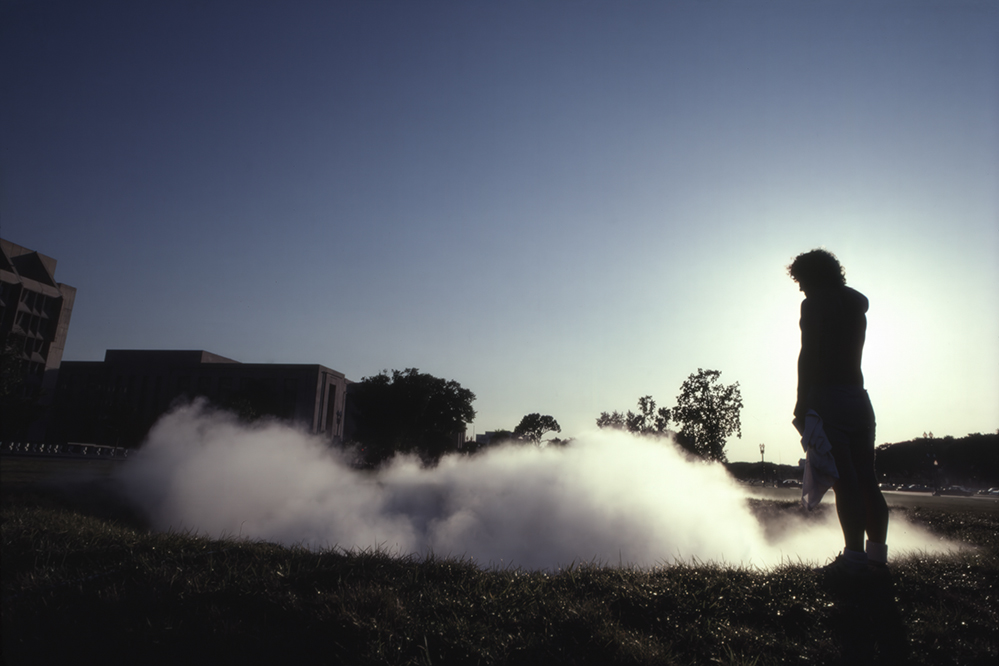
刻々と変化しながらクレーターを埋め尽くしてあふれ出る霧は、地表を渡る風に吹かれて消えていく(第11回国際彫刻会議)
Photo : Hamerman
「霧の彫刻」という表現には、なにかユーモラスな矛盾と逆説が孕まれているようだ。中谷芙二子はそれについて多くを語らない。確かに、堅い物質性を拭い去ってしまった霧の変幻に、お仕着せの彫刻という衣装は似つかわしくはない。
霧は大気の呼吸を視覚化しながら、やがては大気に還る。そのダイナミズムのプロセスに融解してゆくものたち、そして時としてコンセプトたちさえもが、霧に誘われたかのように、静かなインタラクションの響きに包まれていく。あらかじめ綿密に読み取られた微気象としての大気の振舞いも、計算され尽くされた地表のしつらいも、霧の息吹に自らの呼吸を整い始める。「霧の彫刻」は、こうしてすぐれて環境的である。それはいわば物象性の界面に漂う、状況としての、また「こと」としての彫刻なのであろうか。
1960年代後半のアメリカでは、ひと言にはカウンターカルチャーといわれる大きな渦が逆巻いていた。油絵のキャンパスでのコンポジションという既成観念に愛想づかしをして、ものの腐敗過程とその生態的意味を問いつつあった中谷の関心は、やがては「雲の生態」に赴いていたという。デコンポジションの世界への開眼である。ニューヨークを本拠とし、ベル研究所のビリー・クルーバーや画家のロバート・ラウシェンバーグたちが主宰する「芸術と技術の実験グループ」(E.A.T.)に中谷が出会ったのは、その頃のことである。
1970年、E.A.T.グループによる大阪万国博覧会のペプシ館のプロジェクトで、グループ共同の支援と地球化学者の助力を受けて、中谷の創意は人工霧発生装置を生み出し、霧でパビリオンを覆い尽くす環境芸術として結実した。
この装置の考案のプロセスに、アーティストとエンジニアのインタラクションというE.A.T.の考えの典型を見ることができよう。既存の人工霧発生技術は、アーティストの介在によって根本的に革新され、生態系に馴染む産業装置としてその後広く社会に伝播するという結果を伴ったのである。中谷におけるアートと技術の関係が、消費社会を前提にして否応なくまた絶え間なく変化させられて朽ち果ててゆく技術の、応用としてのアートではないことに注目したい。ペプシ館以降現在に至るまで、中谷の作品に用いられきた人工霧発生装置が、技術的にはほとんどその原型のままであるのは、むしろ驚嘆すべきことなのである。
ただ、これは装置としての技術的完成度の高さを物語るばかりではない。いまひとつ見逃せない点は、人工霧を「自然と応答し響き合う媒介項」とするそのアイディアである。「人工」と「自然」といういわば歴史的な対立項としてあったものたちが、この人工霧で融合された。中谷の父・宇吉郎による「人工雪」の創造を経ること三十数年、自然の美の錬金術が再び達成されたのである。この媒介装置を手にして、不可視の大気環境の生態を視覚化し制御することが可能となり、中谷は自らのアートの領域を一挙に広げてしまった。
ペプシ館のプロジェクト以降、多彩に繰り広げられた中谷のプロジェクトのすべてが、インタラクティブな関係性としての環境を創造してきている。スウェーデンの小さな島、デビッド・チュードアの音、子供たちや老人、犬や小鳥たち、掘り込まれたクレーター、川、太鼓、ビル・ビオラのライブ演奏、光と照明、池、紅葉、トリシャ・ブラウンの舞う肉体、「四角」というコンセプト、生態系としての庭、ダンプカー、吊り橋、海、夜桜、構造体-そのひとつひとつが、霧と大気に融解しながら、相対化された新しい関係性に息づく。主体も客体も、主役も脇役もなく。
いわば、「霧の彫刻」の面白さの根源は、霧の環境に包み込まれるひとも物質も事象も、それが依拠する基準座標系(FRAME OF REFERENCE)を取り払われてしまい、新たな関係性のランドスケープに置かれることにあるようだ。ただ、このインタラクティブな彫刻は、見えがかりとしてのランドスケープにかかわるだけではないだろう。それはおそらく「心の内なるランドスケープ」にまでも染み入り、遥かな日々の記憶と面影、無意識に眠り込む夢を甦らせ、未だ形にならない形象をイメージさせる力を秘めているに違いない。
アースワークやランドアート、パフォーマンス、ひいては環境芸術と言ってみても、どこかに物足りなさが残る。すぐれて現代的なこの彫刻の性格を決めつけるのは、霧の振舞いにあらゆるものが包み込まれてゆくのに似て難しい。やはり「状況としての彫刻」と言うしかないのではなかろうか。現代技術と人間実存の状況と危機に深い思索を巡らせたマルティン・ハイデッカーの思いは、いつもの故郷の「野の道」に還っていった。そこには、時として静かに深く霧が立ち込めていたことが思い起こされるのである。
文/森岡侑士

(第11回国際彫刻会議)
CLOUD LAKE Washington D.C. 1980
Children and dogs came everyday to play, running in and out of the fog delighting in the total sensory immersion. (11th ISC)
Photo : Hamerman

(第11回国際彫刻会議)
CLOUD LAKE Washington D.C. 1980
Rolling and hovering about, the fog fills the crater. Overflowing. The fog is taken over by the traveling wind. (11th ISC)
Photo : Hamerman
The expression ‘fog sculpture’ is redolent with humorous contradiction and paradox. But Fujiko Nakaya does not tell us much about that. Yet the normative state of ‘sculpture’ falls short of the transformative impalpable being of fog which denudes objects of their materiality.While it visualizes the breathing of the atmosphere, it is to the atmosphere that it ultimately returns. Things which melt into that dynamism of the process of fog, and sometimes even concepts, are dissolved in the echo of a quiet interaction as if seduced by the fog. Both the behavior of atmospheric micro-climates which are precisely measured in advance as well as the thoroughly calculated and designed ground surface adjust themselves to the breathing of fog. Thus, ‘fog sculpture’ is exceedingly environmental. This ‘sculpture’ hovers between the material and immaterial, object and phenomenon; perhaps it can only be called ‘sculpture of situations’.
It was the late 1960s and the United States was swept by the storm of counterculture. Having exhausted her patience with the academic exercise of composition in oil on canvas and having an ongoing interest rather in the process of organic de-composition and its importance to echo-state, Nakaya says that her interest then shifted to the ‘echo-state of the cloud’. Her eyes were opened to the world of decomposition. It was around that time that Nakaya encountered the New York based group ‘Experiments in Art and Technology’ (E.A.T.) organized by Billy Kluver of Bell Telephone Laboratories and the painter Robert Rauschenberg.
At the Pepsi Pavilion project by E.A.T. at the Osaka Expo in 1970, Nakaya’s aesthetic concerns, with the assistance of phycical scientists and the backing of the group collaboration, was instrumental in bringing forth the technology for artificially generating water fog resulting in an environmental art work which covered the entire pavilion with fog.
The interaction between artist and engineer in the process of developing this system might be regarded as a model of the ideals of E.A.T. Through the mediation of an artist, the existing technology of fog simulation was fundamentally reformed and the resulting environment-friendly water fog later became widely used in agricultural and industrial applications. What should be stressed here is that the relationship between art and technology seen in Nakaya’s work is not that of art as an application of technology which is unceasingly renovated on demand of the consumer society and destined to perish.It is rather the amazing fact that this fog producing device Nakaya used for the Pepsi Pavilion and in her subsequent fog works through the present has kept its technology basically the same as first designed.
That it was instrumental in attaining the high technological level is only one side of the story. We must not overlook her idea of simulated fog as a ‘vehicle of correspondence and reverberation with nature’. The historical binary opposition of artificial/natural are synthesized by this artificial fog. Thirty years after her father Ukichiro created artificial snow crystals, Nakaya achieved another alchemy of natural aesthtics. With this medium at her disposal, it became possible to visualize and simulate the invisible echo-state of the atmosphere; at one stroke she broadened the range of her art.
Since the Pepsi Pavilion project, all of Nakaya’s variously developed projects have created environments of interactive relationality. A small island in Sweden, David Tudor’s sound, children and old people, dogs and small birds, dug-out craters, a river, drums, a live performance by Bill Viola, lighting, a pond, autumn leaves, Trisha Brown’s dancers, the concept ‘Square’, a garden as an eco-system, dump truks, a suspended bridge, cherry blossoms in the night, constructivist solid—-each of these elements fused in fog and in sync with the atmosphere, brought to life a new siting of relations, where none assume the roles of subject or object, lead or support.
Perhaps the most interesting premise of ‘fog sculpture’ is its capacity to envelope people, materials and phenomena in a fog environment such that the frame of reference on which these various agents depend is removed, leaving them as parts of a new relational landscape. But it is not only to the visible landscape that the interactive sculpture has the potential to relate. Certainly it must harbor a latent capacity to penetrate even whithin the ‘landscape inside mind’ to invoke memories and images of the distant past and dreams dormant in the unconscious, and to configure yet unfigured forms. Earth work, land art, performance, environmental art-each term seems insufficient. Defining the character of this remarkable contemporary form of sculpture, which typically envelopes everything in its vicinity, is a devilish task. Perhaps there is no recourse but to call it ‘sculpture of situations’. Martin Heidegger’s profound scrutiny of the condition and crisis of contemporary technology and human existence often returned to ‘the passway’ in his hometown where, we recall, the fog was sometimes setting quietly and deeply.
by Yuji Morioka
(Translation by Bert Winther)
